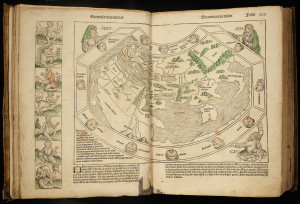On Friday, September 11, 2015, the Fall exhibit, After Gutenberg: Print, Books, and Knowledge in Germany through the Long Sixteenth Century opened. Thomas A. Brady, Jr., a historian of sixteenth-century Germany and Professor Emeritus of History at the University of California, Berkeley, delivered the keynote address. Also marking the opening was a two-day conference, Beyond Tradition: Rethinking Early Modern Europe, which contextualized the exhibit and highlighted institutions, religious practices, and knowledge in Europe during the long sixteenth century.

After Gutenberg: Print, Books, and Knowledge in Germany through the Long Sixteenth Century features materials from Notre Dame’s rare books collection that represent an array of knowledge that circulated widely in Germany in the two centuries following Gutenberg’s breakthrough. Between the mid-fifteenth century and the end of the Thirty Years War in 1648, the printing press made it possible for Germans to learn about their own history as well as about peoples in distant lands; to read previously inaccessible texts in the original languages and in German translations; to explore artistic techniques and scientific principles; and to harness natural resources from untapped sources.
An expanded online exhibit will be released later in Fall that will feature additional images and explanations of the materials on display as well as other objects not in the physical exhibit. Watch for a blog announcement when this is released.
